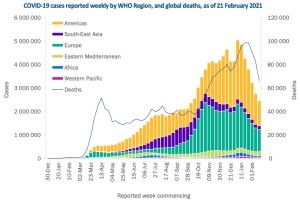
Who can be vaccinated with which vaccine against COVID-19?
Geneva: In the past week (ending February 21, 2021), the five countries reporting the highest number of new cases continue to be the United States of America (480 467 new cases, a 29% decrease), Brazil (316 221 new cases, a 1% decrease), France (131 179 new cases, a 3% increase), the Russian Federation (92 843 new cases, an 11% decrease), and India (86 711 new cases, a 10% increase).
The number of global new cases reported however continued to fall for the sixth consecutive week, with 2.4 million new cases last week, a 11% decline compared to the previous week. The number of new deaths also continued to fall for the past three weeks, with nearly 66 000 new deaths reported last week, a 20% decline as compared to the previous week.
Also read:
- No new COVID fatality reported in 18 States/UTs in the last 24 hours
- Global Corona cases continue to fall, but variants find new territories
A total of four out of six WHO regions reported declines in new cases (Table 1). South-East Asia and the Eastern Mediterranean regions though showed a 2% and 7% increase in new cases, respectively. However, the Americas continued to see the greatest drops in absolute numbers of cases. Meanwhile, the number of new deaths declined in all regions apart from the Western Pacific (6% increase).
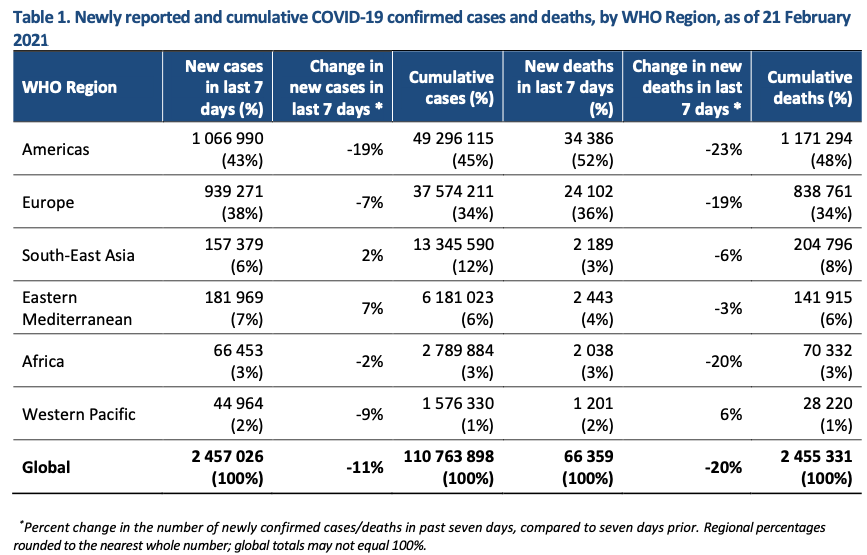
Meanwhile, the WHO recommendations on who may be vaccinated with each of the three vaccines are summarised in Table 2, with the assumption that people falling into high-risk groups (e.g., health workers or people with co- morbidities) are being prioritised as per the WHO SAGE Roadmap on COVID-19 vaccines. It may be mentioned that WHO relies on the Strategic Advisory Group of Experts on Immunization (SAGE) to issue policy recommendations on COVID-19 vaccination to Members States.
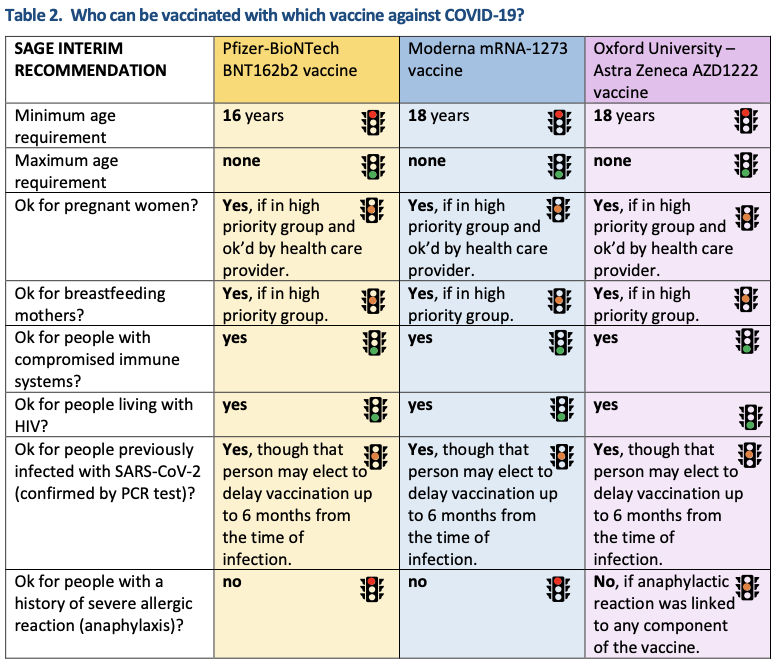
No studies have yet been conducted to compare these three vaccines and despite the above listed similarities, there are also notable differences such as the dose size, the number of doses per container, and the required storage conditions. These differences affect the practices around vaccination, including the handling of vaccine vials and the timeframe within which a vial must be used once thawed or brought to ambient temperatures.
While these vaccines, and others coming through the pipeline, offer a reason to be optimistic, according to the WHO, the current lack of evidence of their effect on transmission, circulating variants of concern, coupled with a continuing limited supply of the vaccines, mean that more data collection is required, and public health and social measures (PHSM) must continue, and should be practised by all individuals regardless of vaccination status, including use of face masks, physical distancing, hand-washing and other measures.
The COVID-19 variants of concern (VOCs)
Increased transmissibility has been reported for some VOCs resulting in increased incidence in settings experiencing community transmission. Public health and social measures (PHSM) remain critically important to curb the spread of SARS-CoV-2, including newly reported variants. Evidence from multiple countries with extensive transmission of VOCs has indicated that the implementation of physical distancing and other PHSM has been effective in reducing COVID-19 case incidence, which has led to a reduction in hospitalisations among COVID-19 patients.
Results of ongoing studies of VOCs are summarised in Table 3 below. While many countries worldwide are currently experiencing a decline in overall SARS-CoV-2 infections likely as a result of the public health and social measures (PHSM) implemented, there has been an increased number of reports of variants which are of concern.
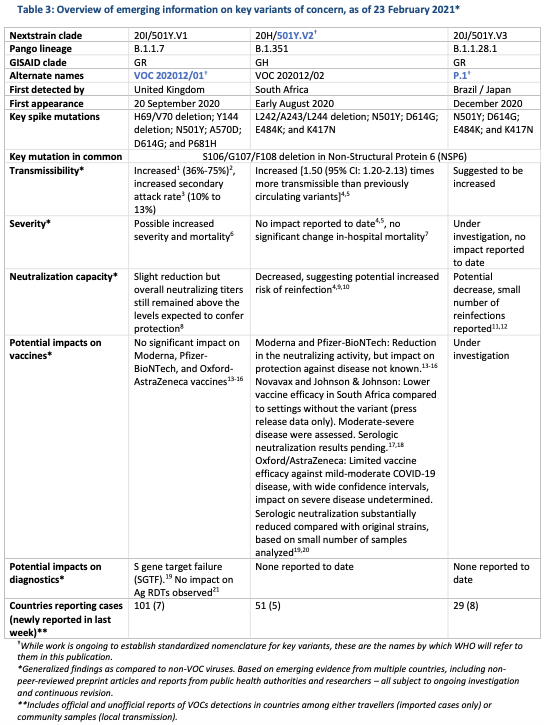
Variant VOC 202012/01
Since our last update on 16 February, VOC 202012/01 has been detected in seven additional countries. As of 23 February, a total of 101 countries across all six WHO regions have reported cases of this variant (Figure 1). Community transmission has been reported in at least 45 countries across five WHO regions, noting that transmission classification is for 23 (23%) countries reporting this variant.
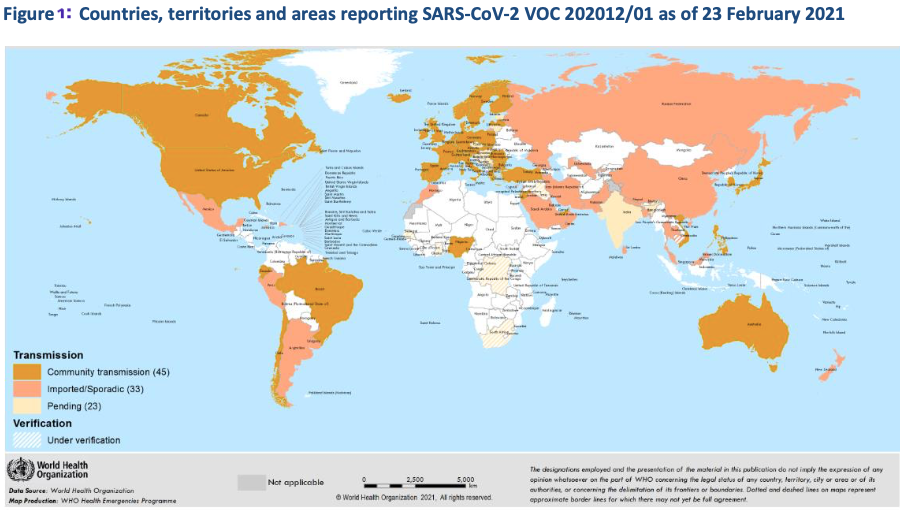
Since the last update on 16 February, 501Y.V2 has been reported from five additional countries– now totalling 51 countries across all six WHO regions (Figure 2). Community transmission of 501Y.V2 has been reported in 13 countries across four WHO regions, noting the transmission classification is currently incomplete for 21 (41%) countries reporting this variant. In several areas within the African Region, variant 501Y.V2 has been reported to comprise a high proportion of sequenced samples.
Recent preliminary evidence suggests that variant 501Y.V2 may compromise immunity indicating potential increased risk of reinfection. There is now growing evidence that the mutations present in this variant may help the virus evade immune system responses triggered by previous infections of SARS-CoV-2 or by vaccines. There has been a report of a SARS-CoV-2 reinfection with the 501Y.V2 variant months after recovering from a first episode of COVID-19 with a more severe clinical presentation.
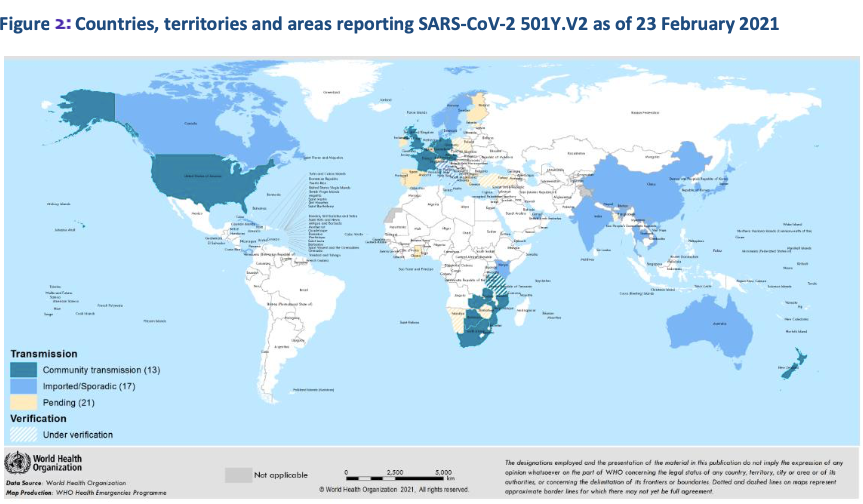
Variant P.1
Since last update, variant P.1 has been reported in eight additional countries. To date, this variant is reported in 28 countries across all six WHO regions (Figure 3). Community transmission of P.1 has been reported in at least three countries in one WHO region, noting the transmission classification is currently for 8 (28%) countries reporting this variant.
In a genomic survey conducted from April to November 2020 in Amazonas State, Brazil, variant P.1 was found to be the most prevalent variant among 148 whole-genomes sequenced, comprising 47% (69/148) of specimens collected from 12 municipalities.
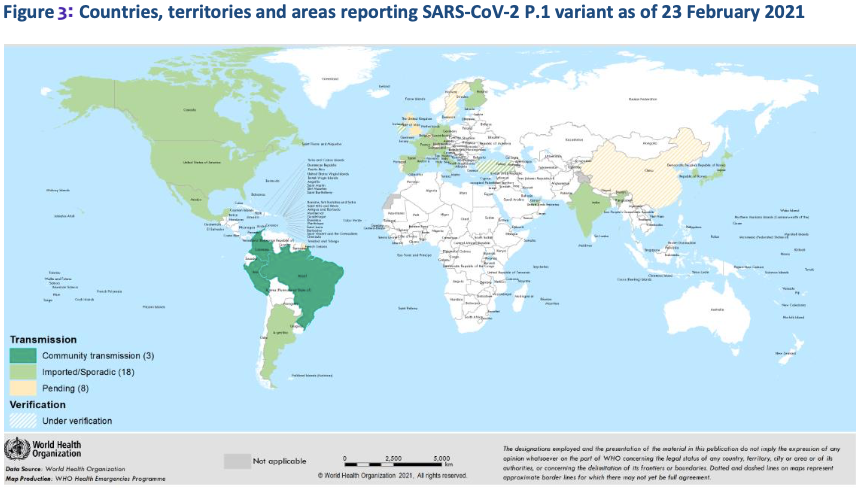
Emerging variants of interest or concern
WHO has been tracking mutations since the beginning of the pandemic. In June 2020, WHO established the SARS-CoV-2 Virus Evolution Working Group (VEWG) to specifically assess new variants.
As of 23 February 2021, over 590 000 sequences of SARS-CoV-2 globally have been uploaded into publicly available databases. New variants of potential interest or concern are continuously emerging and undergo assessment. Here are an update on two such variants currently under review.
Variant B.1.525 (also referred to as VUI-202102/03, and previously UK1188), was first detected in the United Kingdom and Nigeria in December 2020. Since then, it has been detected in at least another 13 countries. This variant is partially similar to the 501Y.V2 variant and contains mutations which may be associated with some degree of biological significance, including the E484K, Q677H and F888L mutations, as well as a similar number of deletions that are contained in B.1.1.7.
A variant of B.1.1.7 with an E484K mutation (labelled VOC 202102/02 by the United Kingdom health authorities) has been detected in South West England. As of 17 February 2021, 26 cases of this variant have been detected in the United Kingdom. Local authorities are responding with enhanced PHSM with the aim to prevent further spread.
The E484K mutation is a mutation in the spike protein and has been associated with antigenic change, as well as increased binding affinity to the human host receptor, Angiotensin Converting Enzyme 2 (ACE2), in conjunction with the N501Y mutation. E484K has been labelled as an escape mutation, so called because it may help the SARS-CoV-2 virus to evade host immune defences. It has been identified as an adaptation of SARS-CoV-2 in at least one immunocompromised patient with long lasting infection. The E484K mutation has been identified independently in several variants (including 501Y.V2 and P.1.), indicating convergent mutations, where distinct lineages independently acquire similar genetic mutations.
Although there is no evidence that this mutation alone is associated with increased disease severity or higher transmissibility, E484K is of significance due to its possible impact on immune response, vaccine efficacy and transmissibility.
Further investigations are required to better understand the importance of specific mutations (and/or clusters of mutations), whether they are identified in emerging variants of interest or concern, as well as ongoing adaptations and evolution of SARS-CoV-2, WHO said.
Meanwhile, in the past week, the South-East Asia Region of the WHO reported over 157 000 new cases, an increase of 2% compared to last week. The region reported over 2100 new deaths, a 6% decrease. The three countries reporting the highest numbers of new cases were India (86 711 new cases; 6.3 new cases per 100 000; a 10% increase), Indonesia (60 650 new cases; 22.2 new cases per 100 000; a 5% decrease), and Sri Lanka (4628 new cases; 21.6 new cases per 100 000; a 26% decrease). The three countries reporting the highest numbers of new deaths this week were Indonesia (1380 new deaths; 0.5 new deaths per 100 000; an 11% decrease), India (660 new deaths; <0.1 new deaths per 100 000; a 2% increase) and Bangladesh (76 new deaths; <0.1 new deaths per 100 000, no change in new deaths reported this week as compared to last week).
The Western Pacific Region reported just under 45 000 new cases the past week, a 9% decrease compared to the previous week. The region reported 1200 new deaths, a 6% increase. The three countries reporting the highest numbers of new cases in the region this week were Malaysia (18 467 new cases; 57.1 new cases per 100 000; a 20% decrease), the Philippines (12 033 new cases; 11.0 new cases per 100 000; a 2% increase), and Japan (10 035 new cases; 7.9 new cases per 100 000; a 9% decrease). The three countries reporting the highest numbers of new deaths this week were the Philippines (561 new deaths; 0.5 new deaths per 100 000; a 41% increase), Japan (505 new deaths; 0.4 new deaths per 100 000; a 12% decrease), and Malaysia (93 new deaths; 0.3 new deaths per 100 000; an 8% decrease).
The Eastern Mediterranean Region reported over 181 000 new cases, a 7% increase compared to last week. The region reported just over 2400 new deaths, a 3% decrease. The three countries reporting the highest numbers of new cases this week were the Islamic Republic of Iran (55 208 new cases; 65.7 new cases per 100 000 population; a 7% increase), Iraq (23 122 new cases; 57.5 new cases per 100 000; a 63% increase) and the United Arab Emirates (22 570 new cases; 228.2 new cases per 100 000; a 2% increase). The highest numbers of new deaths this week have been reported in the Islamic Republic of Iran (526 new deaths; 0.6 new deaths per 100 000 population; a 12% increase), Egypt (363 new deaths; 0.4 new deaths per 100 000; a 10% increase) and Lebanon (336 new deaths; 4.9 new deaths per 100 000; a 16% decrease).
Over 1 million new cases and over 34 300 new deaths were reported in the Region of the Americas this week, a 19% and 23% decrease respectively compared to the previous week. The highest numbers of new cases were reported from the United States of America (480 467 new cases; 145.2 new cases per 100 000 population; a 29% decrease), Brazil (316 221 new cases; 148.8 new cases per 100 000; a 1% decrease) and Mexico (51 537 new cases; 40 new cases per 100 000; a 22% decrease). The highest numbers of new deaths were reported from the same countries, the United States of America (14 747 new deaths; 4.5 new deaths per 100 000; a 31% decrease), Brazil (7276 new deaths; 3.4 new deaths per 100 000; a 2% decrease) and Mexico (6408 new deaths; 5.0 new deaths per 100 000; a 22% decrease).
The European Region reported over 939 000 new cases and over 24 000 new deaths, a decrease of 7% and 19% respectively when compared to the previous week. The three countries reporting the highest numbers of new cases were France (131 179 new cases; 201 new cases per 100 000; a 3% increase), the Russian Federation (92 843 new cases; 63.6 new cases per 100 000; an 11% decrease), and Italy (84 977 new cases; 140.5 new cases per 100 000; an 1% decrease). The highest numbers of deaths were reported from the United Kingdom (3457 new deaths; 5.1 new deaths per 100 000; a 28% decrease), the Russian Federation (3167 new deaths; 2.2 new deaths per 100 000; a 9% decrease) and Germany (2881 new deaths; 3.4 new deaths per 100 000; a 16% decrease).
In the past week, the African Region reported over 66 400 cases and 2000 deaths, a 2% and 20% decrease respectively compared to the previous week. This is the fifth consecutive week the Region reported decreases in both new cases and deaths. The highest numbers of new cases were reported in South Africa (12 304 new cases; 20.7 new cases per 100 000 population; a 25% decrease), Mozambique (6380 new cases; 20.4 new cases per 100 000; a 42% increase) and Ethiopia (6153 new cases; 5.4 new cases per 100 000; a 45% increase). The countries reporting the highest number of new deaths in the past week were South Africa (1119 new deaths; 1.9 new deaths per 100 000; a 32% decrease), Ethiopia (90 new deaths; 0.1 new deaths per 100 000; a 150% increase), and Nigeria (84 new deaths; <0.1 new deaths per 100 000; a 16% decrease).
Source: COVID-19 Weekly Epidemiological Update Data as received by WHO from national authorities, as of February 21, 2021
– global bihari bureau





